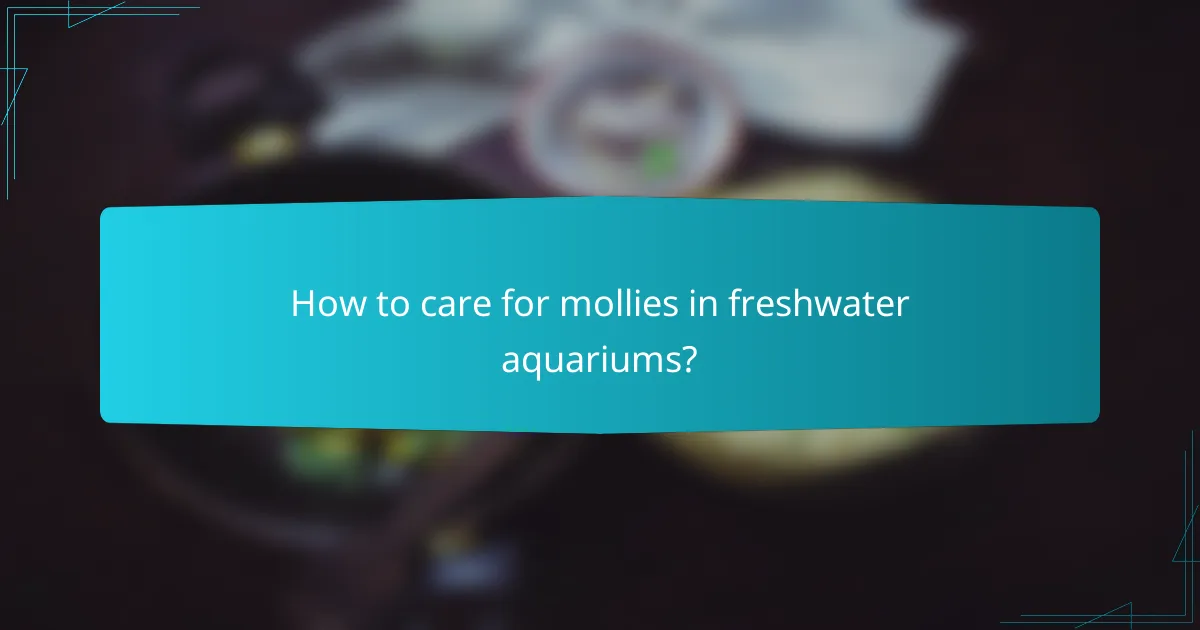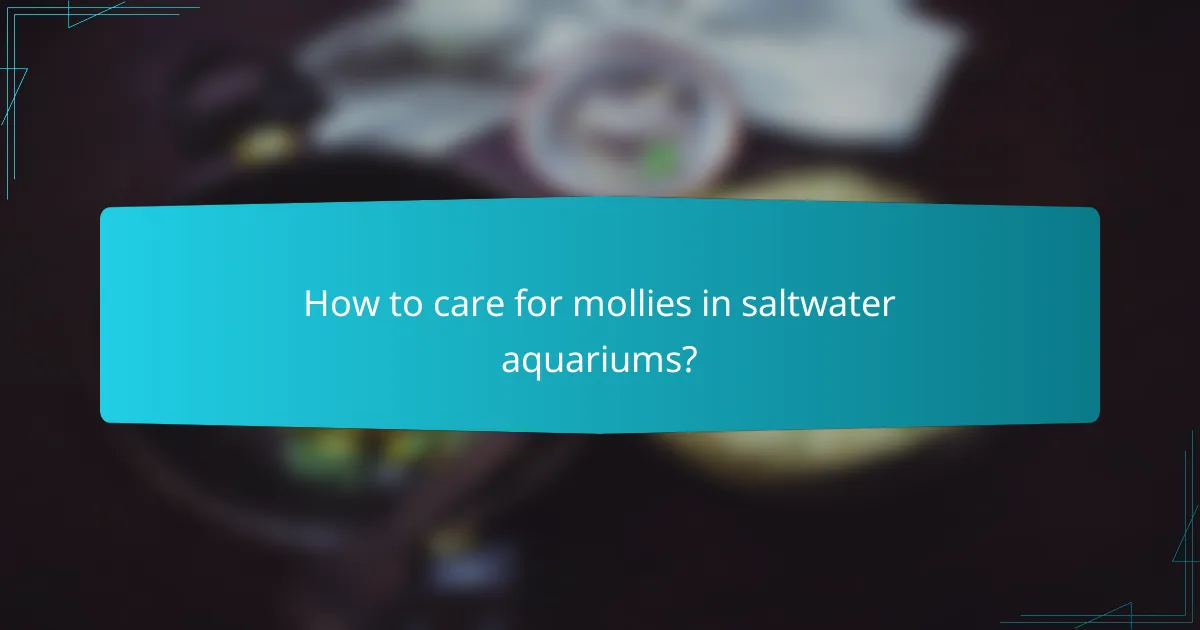Mollies are versatile livebearers known for their adaptability to both freshwater and saltwater environments. These peaceful fish are ideal for aquarists of all levels, thriving in stable conditions and cohabiting well with other species. Proper care, including suitable water conditions and a balanced diet, is essential for their health and well-being.

How to care for mollies in freshwater aquariums?
Caring for mollies in freshwater aquariums involves maintaining suitable water conditions, providing a balanced diet, and ensuring compatible tank mates. These adaptable fish thrive in a stable environment, making proper care essential for their health and well-being.
Optimal water conditions
Mollies prefer slightly alkaline water with a pH range of 7.0 to 8.5. The temperature should be maintained between 24°C and 28°C (75°F to 82°F) to ensure their comfort and activity levels.
Regular water changes of 10-20% weekly help maintain water quality and remove toxins. It’s also beneficial to use a good filtration system to keep the water clean and oxygenated.
Feeding guidelines
Mollies are omnivorous and require a varied diet for optimal health. High-quality flake food, pellets, and occasional treats like frozen or live food such as brine shrimp or bloodworms are recommended.
Feed them 1-2 times a day, providing only as much food as they can consume in a few minutes to prevent overfeeding and water pollution.
Tank mates compatibility
Mollies are generally peaceful and can coexist with a variety of other species. Suitable tank mates include guppies, tetras, and other small, non-aggressive fish.
Avoid housing them with aggressive species or those that may nip at their fins, as this can lead to stress and health issues.
Common health issues
Mollies can be susceptible to common fish diseases such as ich, fin rot, and velvet disease. Regular observation for signs of distress, such as changes in behavior or appearance, is crucial.
Maintaining clean water and a stress-free environment significantly reduces the risk of health problems. Quarantine new fish before introducing them to the main tank to prevent the spread of diseases.

How to care for mollies in saltwater aquariums?
Caring for mollies in saltwater aquariums involves understanding their adaptability and specific needs. These fish can thrive in brackish environments, but proper acclimatization and maintenance are crucial for their health and well-being.
Saltwater adaptation techniques
To successfully adapt mollies to saltwater, gradual acclimatization is essential. Start by mixing salt into their freshwater environment slowly over several days, aiming for a salinity level around 1.020 to 1.025 specific gravity. Monitor their behavior closely during this transition to ensure they are adjusting well.
Additionally, consider using a hydrometer to measure salinity accurately. This helps prevent stress and potential health issues associated with sudden changes in water chemistry.
Feeding differences
Mollies in saltwater require a diet that is slightly different from their freshwater counterparts. They thrive on high-quality flakes or pellets designed for marine fish, supplemented with algae and vegetable matter. This ensures they receive the necessary nutrients to maintain their health in a saline environment.
It’s important to avoid overfeeding, as uneaten food can lead to water quality issues. A good rule of thumb is to feed small amounts two to three times a day, ensuring they consume everything within a few minutes.
Tank setup requirements
Setting up a saltwater tank for mollies requires specific considerations. Use a well-established filtration system that can handle the bioload, and ensure the tank has adequate aeration and water movement. Live rock can also provide hiding spots and grazing surfaces for the fish.
Maintain stable water parameters, including temperature (around 24-27°C), pH (between 7.8 and 8.4), and salinity. Regular water changes of 10-20% every couple of weeks will help keep the environment healthy and balanced.

What are the best mollies for beginners?
The best mollies for beginners include the Black Molly, Dalmatian Molly, and Gold Dust Molly. These species are known for their adaptability to various water conditions and peaceful nature, making them ideal for novice aquarists.
Black Molly characteristics
Black Mollies are easily recognizable due to their solid black coloration. They typically grow to about 3-4 inches in length and thrive in both freshwater and saltwater environments, making them versatile for different aquarium setups.
These fish prefer slightly alkaline water with a pH range of 7.5 to 8.5 and a temperature between 72°F and 82°F (22°C to 28°C). They are social creatures, so keeping them in groups of at least three is recommended to reduce stress.
Dalmatian Molly traits
Dalmatian Mollies are distinguished by their white bodies adorned with black spots, resembling a Dalmatian dog. They can grow similarly to Black Mollies, reaching around 3-4 inches in size.
These fish are known for their peaceful temperament and adaptability. They thrive in a pH range of 7.5 to 8.5 and enjoy a temperature of 75°F to 80°F (24°C to 27°C). Like Black Mollies, they benefit from being kept in groups, which enhances their social behavior.
Gold Dust Molly features
Gold Dust Mollies are characterized by their shimmering golden-yellow color with speckles, giving them a unique appearance. They typically reach a size of 3-4 inches and are equally adaptable to freshwater and saltwater conditions.
These mollies prefer a slightly alkaline environment with a pH of 7.5 to 8.5 and a temperature range of 75°F to 80°F (24°C to 27°C). They are friendly and can coexist with various other peaceful fish species, making them a great addition to community tanks.

How do mollies breed?
Mollies breed through a process called livebearing, where females give birth to free-swimming fry instead of laying eggs. They are known for their adaptability and can breed in both freshwater and saltwater environments, making them popular among aquarists.
Breeding conditions
To encourage successful breeding, mollies require a suitable environment that mimics their natural habitat. This includes stable water temperatures between 24-28°C (75-82°F), a pH level around 7.0-8.5, and good water quality with regular maintenance. Providing plenty of hiding spots, such as plants or decorations, can help reduce stress during breeding.
Additionally, a balanced diet rich in nutrients will support the health of both the breeding pair and the fry. High-quality flakes, algae, and occasional live or frozen foods can enhance their reproductive success.
Gestation period
The gestation period for mollies typically lasts around 4-6 weeks, depending on factors like water temperature and the health of the female. During this time, it is essential to monitor the female for signs of impending birth, such as a swollen abdomen and increased hiding behavior.
Once the fry are ready to be born, the female will give birth to anywhere from a few dozen to over a hundred fry at once. It’s crucial to separate the fry from the adults shortly after birth to prevent them from being eaten.
Care for fry
Caring for mollies’ fry requires attention to their specific needs. Initially, they should be fed specialized fry food or finely crushed flakes to ensure proper growth. Maintaining clean water and stable conditions is vital for their survival.
As the fry grow, gradually introduce them to larger food options and consider transferring them to a separate tank to avoid competition with adults. Regular water changes and monitoring for any signs of disease will help ensure a healthy environment for the young mollies.

What are the differences between freshwater and saltwater mollies?
Freshwater and saltwater mollies differ primarily in their habitat requirements and adaptability. While both types can thrive in various environments, their specific needs for salinity and water chemistry vary significantly.
Habitat preferences
Freshwater mollies are typically found in rivers, lakes, and ponds, where the water salinity is low. They prefer environments with plenty of vegetation and hiding spots, which provide safety and breeding grounds.
In contrast, saltwater mollies inhabit brackish waters, which are a mix of fresh and saltwater. These fish can tolerate a range of salinity levels, making them adaptable to estuaries and coastal areas.
Behavioral traits
Both freshwater and saltwater mollies are known for their peaceful nature, making them suitable for community tanks. They tend to be social fish, often swimming in groups and displaying friendly interactions with other species.
However, freshwater mollies may exhibit slightly more territorial behavior, especially during breeding. It’s essential to provide ample space and hiding spots to minimize aggression during these times.
Color variations
Mollies come in a variety of colors, with freshwater species often showcasing bright hues like orange, black, and gold. These vibrant colors can enhance the aesthetic appeal of aquariums.
Saltwater mollies, while also colorful, may present more muted tones, often with patterns that help them blend into their natural habitats. Breeders have developed numerous color morphs for both types, allowing for diverse aquarium displays.

What are the benefits of keeping mollies?
Mollies are versatile fish that thrive in both freshwater and saltwater environments, making them an excellent choice for various aquariums. Their adaptability, peaceful demeanor, and ease of care contribute to their popularity among fish enthusiasts.
Peaceful nature
Mollies are known for their calm and friendly behavior, which makes them suitable for community tanks. They typically coexist well with other non-aggressive species, reducing the likelihood of territorial disputes.
When introducing mollies to an aquarium, ensure that tank mates are similarly peaceful to maintain harmony. Avoid pairing them with aggressive fish, as this can lead to stress and health issues.
To foster a tranquil environment, provide ample swimming space and hiding spots. This setup allows mollies to explore while minimizing potential conflicts with other fish.










